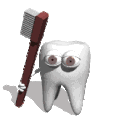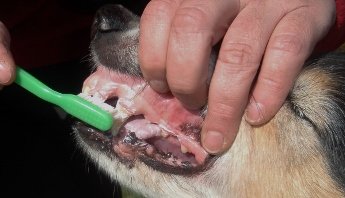Picture shows Little Heike-mothers teeth. Take good care of your dogs teeth, and then you will have such fantastic teeth on your dog like I have on my 13 year young Little Heike-mother
CARING FOR YOUR DOGS TEETH
Things to use for taking care of your dogs teeth
Little Heike-mother is getting her teeth brushed
Take good care of your dog’s teeth. Several years ago I stopped giving my dogs kibble and started to make food for them at home. And I have never had tartar or plaque or any other problems with my Collies teeth.
Dogs are not as prone to cavities as us humans are, but can still develop problems like tartar and plaque buildup and gingivitis.
Bad breath is often the first sign of a problem.
As with humans, canine dental problems can actually lead to
life-threatening infections and issues including heart, liver, and kidney disease.
Once a week, with your dog facing you, lift his lips and examine his gums and teeth.
The gums should be pink, not white or red, and should show no signs of swelling. His teeth should be clean, without any brownish tartar.
There are toothbrushes and toothpaste you can buy to brush your dog’s teeth. Toothbrushes that you can wear over your finger are also available and allow you to give a nice massage to your dog's gums. Only use a toothpaste made for dogs, most human toothpastes include fluoride which is extremely poisonous to dogs.
It’s smart to start brushing a puppies teeth, so that he/she get used to it. First get your dog used to the idea of having her/his teeth brushed. Massage her/his lips with your finger in a circular motion for 30 to 60 seconds once or twice a day for a few weeks. Then move on to her/his teeth and gums. When your dog seems comfortable being touched this way, put a little bit of dog-formulated toothpaste and water on her/his lips to get her/him used to the taste. Finally, apply the toothpaste to her/his teeth for a gentle brushing.
Don’t overdo it the first few times. Start slowly and quit if your dog gets agitated, even if you don’t brush the whole mouth. Speak soothingly and pleasantly during the brushing and reward your dog with a treat afterwards.
I am giving my Collies bones to chew on – like raw chicken-wings and raw oxtail, this is something that help getting rid of builtup and keep the teeth strong.
When you’re dogs have a checkup at your veterinarian also check the teeth, and if you notice any of these signs of dental problems, then take your dog to the veterinarian:
Bad breath
Change in eating or dog chewing habits
Pawing at the face or mouth
Depression
Excessive drooling
Discolored, broken, missing or crooked teeth
Red, swollen, painful or bleeding gums
Yellowish/brown tartar crust along the gum line
Tumors in the gums
Loose teeth
Cysts under the tongue
Some teeth and mouth diseases to be aware of :
Periodontal disease : is a painful infection between the tooth and the gum that can result in tooth loss and spread infection to the rest of the body. Signs are loose teeth, bad breath, tooth pain, sneezing and nasal discharge.
Gingivitis: is an inflammation of the gums caused mainly by accumulation of plaque, tartar and disease-producing bacteria above and below the gum line. Signs include bleeding, red, swollen gums and bad breath. It is reversible with regular teeth cleanings
Halitosis / or bad breath : can be the first sign of a mouth problem and is caused by bacteria growing from food particles caught between the teeth or by gum infection. Regular tooth-brushings are a great solution.
Swollen gums: develop when tartar builds up and food gets stuck between the teeth. Regularly brushing your dog's teeth at home and getting annual cleanings at the vet can prevent tartar and gingivitis
Proliferating gum disease: occurs when the gum grows over the teeth and must be treated to avoid gum infection. An inherited condition common to boxers and bull terriers, it can be treated with antibiotics
Mouth tumors: appear as lumps in the gums. Some are malignant and must be surgically removed.
Salivary cysts: look like large, fluid-filled blisters under the tongue, but can also develop near the corners of the jaw. They require drainage, and the damaged saliva gland must be removed.
Canine distemper teeth : can occur if a dog had distemper as a puppy. Adult teeth can appear looking eroded and can often decay. As damage is permanent, decayed teeth should be removed by a vet
By keeping your dogs’ teeth clean you both can smile with some pearly white teeth



